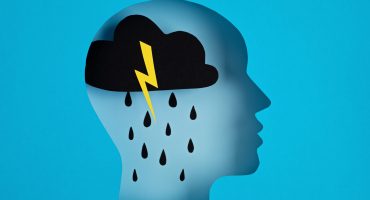In Part 1 of “What Causes OCD in Adolescents?” author Michael Angelo, MSJ, LCPC, examined the reasons behind obsessive compulsive disorder and also looked at the prevalence of OCD in children as young as 4 years old. In Part 2, he discusses the growing evidence that a specific form of childhood OCD might actually be an autoimmune disorder, whose origins are the same bacteria that causes strep throat and scarlet fever.When it comes to developing obsessive compulsive disorder as a child, genes likely play a role. And yet, no single gene has been found that causes OCD. More likely, a combination of genetic markers and environmental occurrences are required for the disorder to develop. At the same time, no one really knows what other factors might be involved beyond genetics. Perhaps an illness or even ordinary life stressor might induce the activity of genes associated with the symptoms of OCD, according to the International OCD Foundation (IOCDF).
Some experts think that OCD that begins in childhood might be different from the OCD that begins in adulthood. For example, a recent review of twin studies has shown that genes play a larger role when OCD starts in childhood—45 percent to 65 percent—compared to when it begins in adulthood—27 percent to 47 percent (IOCDF, 2010).
However, a child might also develop OCD with no previous family history. Research in this area has revealed that although OCD is usually thought to be caused by a combination of stress, genetic predispositions, and disruption of petrochemicals such as serotonin, there is growing evidence that a specific form of childhood OCD might actually be an autoimmune disorder.
PANDAS: A Different Kind of “Animal”
The Pediatric Autoimmune Neuropsychiatric Disorders Associated with Streptococcal Infections, or PANDAS form of OCD, is thought to be triggered by an infection of the same bacteria that causes strep throat and scarlet fever, according to Ann Graybiel, Department of Brain and Cognitive Science and the McGovern Institute for Brain Research, Massachusetts Institute of Technology (2008).
“As the child’s immune system fights the strep infection, it becomes confused and starts to attack an area of the brain called the basal ganglia,” said Ann Graybiel, Department of Brain and Cognitive Science and the McGovern Institute for Brain Research, Massachusetts Institute of Technology (2008). “Although changes in a number of brain areas underlie symptoms of OCD, abnormalities of the basal ganglia have been associated with symptoms of OCD.”
Of course, lots of children get strep throat when they’re young. It is a common infection. Not all of them develop the PANDAS form of OCD, though. Research has shown that only children genetically predisposed to OCD or tics are vulnerable to developing this form of OCD. Still, about 25 percent of children with OCD have the PANDAS subtype (Graybiel, 2008).
The PANDAS form of OCD has a few key symptoms that enable doctors to distinguish it from more typical forms of childhood OCD. For example:
- OCD develops slowly; the onset of PANDAS is rapid.
- PANDAS occurs closely with strep. However, regular OCD can occur at any time.
- Unlike regular OCD, children with the PANDAS form of OCD usually have involuntary movements of the arms, legs, and face.
- PANDAS usually develops between the ages of 3 and before puberty.
If PANDAS is suspected, the first line of treatment is a round of antibiotics to knock out the strep infection, according to Dr. Patrick McGrath, author of The OCD Answer Book (2007). Sometimes that’s not enough, and more invasive procedures such as a plasma exchange are necessary to remove harmful antibodies from the bloodstream.
Evidence suggests that changes in the immune system can accompany mental illnesses such as depression and schizophrenia. But there is no conclusive evidence that problems with the immune system are related to the development of adult forms of OCD, said McGrath. At present, it appears that strep infections can only trigger symptoms of OCD in children between the ages of 3 and puberty (2007).
The Shame and Embarrassment of OCD
Imagine being a child or adolescent and having OCD, regardless of how it occurs. Shame and embarrassment can dominate the person’s thinking.
Many young people with OCD fear that they are going crazy, and are hesitant to talk about their thoughts and behaviors. Understanding the special impact that the disorder has on their lives is important in helping children and teens get the correct treatment, according to S. Evelyn Stewart, M.D., Assistant Professor, Harvard Medical School, International OCD Foundation Scientific Advisory Board (2010). Good communication between parents and children can increase knowledge of the issue and help parents appropriately support their child. Some issues that youth and parents should know about OCD include:
Disrupted Routines: Children or teens with OCD can find daily living difficult. In the morning, they feel they must do their rituals correct or the rest of the day will not go well. In the evenings, they must finish all of their compulsive rituals before they go to bed. Some youths even stay up late because of their OCD, and are often exhausted the next day.
Problems at School: OCD can affect homework, attention in class, and school attendance. If this happens, parents need to be an advocate for their child. “It is your right under the Disabilities Education Act (IDEA) to ask for changes from the school that will help your child succeed,” said Stewart (2010).
Physical Complaints: Symptoms can include poor nutrition and loss of sleep, often leading to physical illness.
Social Relationships: These are impacted through the stress of hiding rituals from peers, time spent with obsessions and compulsions, and how their friends react to the OCD-related behaviors.
Problems with Self-Esteem: Young people with OCD worry that they are “crazy” because their thinking is different than their friends and family. Self-esteem takes a hit, as the person feels “bizarre” and “out of control,” said Stewart (2010).
Anger Management Problems: Children with OCD have very demanding compulsions. They can impose these behaviors on their parents. When parents don’t comply, young people can become anxious and angry. Still, parents must find ways to set reasonable limits with their children (2010).
Additional Mental Health Concerns: Children and teens with OCD are more likely to have additional mental health issues than those who do not have the disorder, Stewart said. Sometime these other disorders can be treated with the same medicine prescribe to treat the OCD.
For example, when children take anti-OCD medicine, they can find that their depression or anxiety improves. On the other hand, ADHD, tic disorders, or disruptive behavior disorders usually require additional treatments, including medicines not specific to OCD.
Parents should also be cognizant of obstacles to treatment, including the following:
Hiding Symptoms: Some young people choose to hide their symptoms, often in fear of suffering embarrassment or being stigmatized. This causes many children and teens with OCD to not seek the help of a mental health professional until many years after the onset of their symptoms (Stewart, 2010).
Less Public Awareness of OCD: Until recently, many people with OCD did not know there was even a name for their illness, and with no name, they assumed there was no treatment, said Stewart (2010).
Lack of Proper Training of Health Professionals: Those with OCD often get the wrong diagnosis from a health professional, and need to see several doctors and spend several years with incorrect treatment before getting the right diagnosis and treatment.
Difficulty in Finding a Local Therapist Who Can Effectively Treat OCD: Many professional engage in talk therapy; far fewer specialize in cognitive behavioral therapy (CBT) and exposure response prevention therapy (ERP). Experts agree that CBT is the treatment of choice for those with OCD. Research indicates that a 50 percent to 80 percent reduction in OCD symptoms occurs over the course of 12 to 20 sessions of CBT and ERP treatment. This number of sessions might even be lessened if the therapy is performed in an intensive outpatient program (Last & Strauss, 1989).
The Person, Not OCD, Is in Charge
Working with a trained CBT therapist, children and adolescents learn that they are in charge, not their OCD, according to Aureen Pinto Wagner, Ph.D., Clinical Associate Professor of Neurology, University of Rochester, and the International OCD Foundation Scientific Advisory Board (2010).
Using ERP, young people can learn to do the opposite of what OCD tells them to do: Face their fears gradually, in small steps (exposures), without giving in to the rituals (response prevention).
“ERP helps them find out that their fears don’t come true and that they can get used to the scary feeling, just like they might get used to cold water in the swimming pool,” said Wagner (2010).
For example, a teenager who repeatedly touches things in his room to prevent bad luck would learn to leave his room without touching anything. He might feel very scared at first, but after some time, the anxiety goes away as he gets used to it. Also, he discovers that nothing bad happens.
“At first, ERP may sound scary to many children and teenagers,” Wagner said. “They may not be ready to try it. It is important to find a CBT therapist who is experienced in working with children with OCD. An experienced therapist will be able to get your child ready for ERP by making it kid-friendly” (Wagner, 2010).
When young people understand how the therapy works, they might be more willing to deal with the initial anxiety experienced during ERP because they know that while the anxiety will increase initially, it will go down over time. Parents need to be involved in their child’s treatment as well, under the therapist’s guiding, according to Wagner (2010).
Benefits of OCD Medicine for Severe Symptoms
Drug therapy should only be considered when there are moderate to severe OCD symptoms, said Garcia. Both CBT and medicine effectively treat OCD in children and teens (2010).
Antidepressants are usually the first kind of medicine a psychiatrist will try, since some medications originally developed for depression also appear to have some passive effects on OCD (McGrath, 2007). These include Selective Serotonin Reuptake Inhibitors, or SSRIs, such as:
- Celexa
- Lexapro
- Luvox
- Prozac
- Paxil
- Zoloft
Antianxiety medications such as benzodiazepines (BDZs) are also used on people with OCD, including children and adolescents. BDZs can help decrease activity in the midbrain, which can calm a person with OCD, lessening the effects of their obsessions and desires to do compulsions, according to McGrath (2007). BDZ medications include:
- Valium
- Klonopin
- Ativan
- Tranzene
- Xanax
While SSRIs and BDZs decrease OCD symptoms, they do not cure the disorder. No research exists that says you can cure OCD. However, OCD is usually well controlled when the right treatment is in place, including medication, according to Last & Strauss (1989).
The symptoms can often return when the child stops taking the medicine, though (Last & Strauss, 1989).
Therapy and Medication: The Best Defense
In the largest child OCD treatment study to date, remission occurred in about 1 in 5 children on medicine and in more than half of those with medicine and CBT (Apter, Bernhout, & Tyano, 1984). In addition, many more children had improvement, but not full remission. Some children will have no response at all to some medicines, but it does not mean that other medicines will not help (1984).
The bottom line is that individuals who take medication in combination with therapy have fewer relapses than individuals who take medication alone. Though people who suffer from the disorder—whether child, adolescent, or adult—cannot cure their OCD or ignore it into submission, they can learn coping strategies and engage in behavioral changes that can, at least outwardly, seem like a cure.
One of the most important strategies is to examine feelings as they relate to thoughts and behaviors. Our feelings include our thoughts, which affect how we behave. So if we change how we behave, we can change our thoughts—and our feelings will be challenged and can change as well.
When it comes to OCD, it’s not how you feel, but what you do, that counts, said Dr. Jeffery Schwartz, a psychiatrist at the UCLA School of Medicine. Because when you do the right things, feelings tend to improve as a matter of course. But spend too much time being overly concerned about uncomfortable feelings and you might never get around to doing what it actually takes to improve.
“Focus your attention on the mental and physical actions that will improve your improve life,” Schwartz said. “And remember: ‘It’s not me; it’s my OCD’” (1996).
References:
Apter, A., Bernhout, E., & Tyano, S. (1984). Severe obsessive compulsive disorder in adolescence: a report of eight cases. Journal of Adolescence. 7(4): 349-58.
Graybiel, A. M. (2008). Habits, rituals, and the evaluative brain. Annual Review of Neuroscience. 31: 359-87.
Last, C. G., & Strauss, C. C. (1989). Obsessive compulsive disorder in childhood. Journal of Anxiety Disorders. 3(4): 295-302.
McGrath, P. (2007). The OCD answer book. Naperville, IL: Sourcebooks, Inc.
Pinto-Wagner, A. (2010). Cognitive behavior therapy (CBT) for children and teens. International OCD Foundation website: http/www.ocfoundation.org. Retrieved February 24, 2011, from http:/www.ocfoundation.org/CBT_Kids.aspx
Schwartz, J. M. (1996). Brain lock: Free yourself from obsessive compulsive behavior. New York: ReganBooks.
Stewart, S. E. (2010). Medicines for OCD in children and teens. International OCD Foundation website: http/www.ocfoundation.org. Retrieved February 24, 2011, from http:/www.ocfoundation.org/Meds_Kids.aspx
Stewart, S. E. (2010). OCD in children and teens. International OCD Foundation website: http/www.ocfoundation.org. Retrieved February 24, 2011, from http:/www.ocfoundation.org/childOCD.aspx
What causes OCD? (2010). International OCD Foundation website: http/www.ocfoundation.org. Retrieved February 24, 2011, from http:/www.ocfoundation.org/causes.aspx




